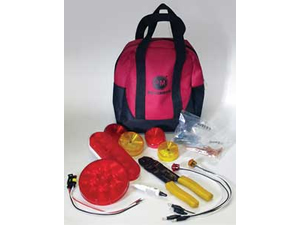br /> “For those running sensitive electronics (like CPAP machines) or products that are plugged into their own chargers—a drill or a toothbrush—sine wave is the preferred choice,” says Carlson. “Since sine wave is the same power as what you get at home, the voltage is consistent without spikes or drops.
“But, in most cases, modified sine wave power is just fine in operating most electronics and appliances.
“With a sine wave unit, there is a slight decrease in the efficiency rating, since electronics within the inverter use power to keep electrical levels consistent. We have an 87% efficiency rating on a Xantrex sine wave unit compared to 92% on a modified inverter. It’s like the difference between running a 6-cylinder car versus 4-cylinder car. That 4-cylinder car may get a bit better fuel economy, but the 6-cylinder is better in overall performance.”
3) Is it OK for fleets to install the inverter?
Carlson says that most technicians will have no problem handling installation, “and Xantrex does offer fleet training programs to our customers. It’s our recommendation that inverters over 300 watts feature hard-wiring and fusing.”
Carlson says to make sure there is adequate ventilation around where you place the inverter to allow heat to dissipate. “And you have to be cognizant of wire sizing and the distance between the inverter and plug-ins, which can be put in the sleeper; plus the distance between the battery and inverter.”
Preventing lighting-related maintenance issues According to the lighting experts at Peterson Manufacturing, as part of a comprehensive maintenance program, a conscientious inspection program can prevent an out-of-compliance condition before it occurs. Maintenance personnel should go beyond just verifying that lights are illuminated. They should regularly look for: 1 Lamp lenses and housings that are cracked or fatigued; 2. Harness or pigtail conductors that are brittle, chaffed, stripped or badly kinked; 3. Corroded terminals and plugs; 4. The failure of individual diodes within an LED lamp assembly, which could be an early indication of moisture or corrosion intrusion. In addition, always follow these good maintenance practices: • Periodically use dielectric grease to protect bare metal terminals (if they are not otherwise sealed from water and corrosive chemicals). • When a situation requires emergency repairing, splice wires together using glue-filled, heat shrink crimp connectors to effect a completely sealed connection. |
According to Carlson, most fleets want the convenience of a factory-installed and warranted inverter. “Do an OEM install when you purchase a new truck, or have the installation done by an authorized dealer,” recommends Carlson. “The OEMs have installation down to a science and it’s done on the line to rigid specs. Truck and aftermarket dealers also have the experience, so it’s worth spending a few extra bucks to have the installation done right, the first time, should your own staff not have the time or expertise.”
4) What kind of reliability can I expect?
You will pay more for an inverter that has a “Regulatory Listed” approval—such as UL or ETL with UL458 rating. This means the inverter was inspected and approved by an independent agency that safeguards against issues with electricity. Buying an inverter that is not Regulatory Listed tells you “buyer beware.”
“Buy an inverter with a regulatory listing. This is the most important safety point I can make, and in fact, TMC’s RP163 calls out this UL listing for all inverters and chargers installed in a truck. What’s more, TMC’s RP160, which discusses DC and AC wiring in a truck, has requirements that are automatically met by UL458 listed inverters. The main point being that the neutral and ground are bonded together within the inverter.”
Carlson says that inverters installed by truck manufacturers all are UL approved, but inverters sold at truck stops are not.
5) Should I get an inverter with a battery charger?
“Yes, if your drivers can use ‘shore power’ (electrical outlets),” says Carlson. When plugged in, drivers can run everything through the inverter, as power is automatically transferred to the receptacles for as long as they want, plus they can recharge and top off the batteries. The more shore power is used, the better, as it prolongs the life (by 20% to 30%) of the batteries. This happens by keeping batteries fully charged, offsetting parasitic loads, and reducing the number of cycles.”
According to Carlson, most installations use the inverter off the truck’s starting batteries, and quality inverters will have a low voltage disconnect (LVD) to shut down when voltage drops to 11.7 volts. This ensures the truck will have enough juice to start.
“Check on the LVD feature of your trucks before you buy an inverter,” cautions Carlson. “Many inverters on the market will run the batteries down to 10.5 volts, which will let drivers run electrical devices longer in the cab and sleeper. However, your drivers won’t then be able to start the truck unless the truck comes equipped with its own LVD.
“Another option is to run two dedicated deep-cycle batteries and connect them to the inverter. Deep-cycle batteries were designed to be drawn down to a 50% state of charge, or 10.5 volts. That will give your drivers double to triple the amount of continuous power to run hotel loads.”
6) What is the Purpose of an Inverter if I already have a Fuel-Fired APU?
The addition of an inverter to a truck electrical system will reduce hours of use on a diesel-fired APU (assuming that the APU does not already have shore power compatibility). “And, it will reduce maintenance costs and increase APU life,” says Carlson. “An inverter can be used for hotel loads in the cab as long as environmental conditions do not require air conditioning. When those conditions happen, just power up the APU.”
With this set-up, the APU would turn on only if the batteries dropped to a low level. Once the batteries are charged, the APU can shut off again. “This significant reduction in APU run time means a quick payback on the cost of the inverter,” says Carlson.


